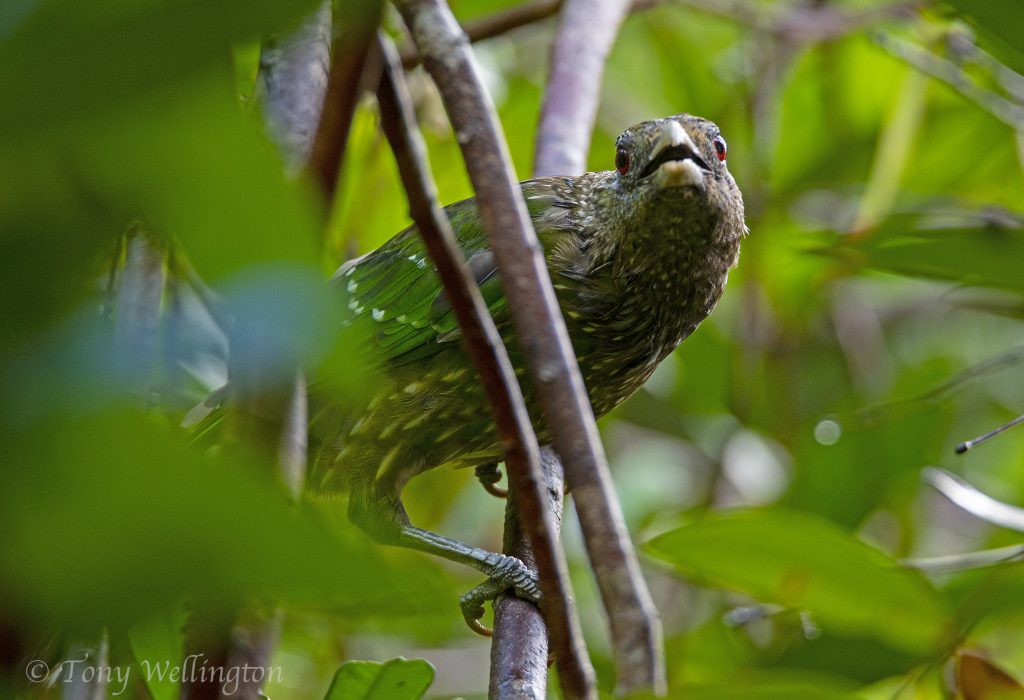Green catbirds are so named because they are green and sound like cats, although some people think they sound more like a crying human child. They tend to go quiet in winter, but come spring all hell will break loose, with that crazy-ass sound resounding through their territories across Noosa Shire.
The green catbird is a member of the bowerbird family. Unlike its bowerbird cousins, catbirds establish lifelong monogamous pairs. The male doesn’t build a bower, because he doesn’t need to impress multiple females. But some vestige of his bowerbird ancestry remains, because he will clear a performance stage on the forest floor from which he can display to his ladylove. Of greater importance in pair bonding is the male’s ability to bring home the bacon – or, at least, the fig. Males bring food to females all year, not just during breeding season. Catbirds are frugivores.
There have been very few studies carried out on these animals. The first research appeared in the 1980s. A 2016 study in the Illawarra region looked at catbird diets and found they consumed fruit from 20 different species of native plant, which was a quarter of all the fruiting species in the region. For the first time it was found that they also eat sections of lantana stems, a plant that is generally considered to be poisonous. I’ve photographed them locally eating lantana fruit.

These are generally secretive birds that don’t like to be watched. However, being determinedly territorial, they are often observed attacking their own reflection in windows and car mirrors. When a dwarf lillypilly sets fruit beside a window at our abode, a crazy-ass catbird arrives each afternoon to consume the fruits and bash its beak against the window. The first time it happens, one of us ends up rushing to answer the knocking on the front door. But we learn faster than catbirds, and for a few weeks it’s just an amusing entertainment.
The average home range for a pair of catbirds is five acres. Patrolling the territory takes up a large proportion of their daily regimen. That territory will usually contain at least one native fig tree.

We are lucky to have them in Noosa. They haven’t been spotted any further northwards than Cooloola, so we’re at the top of a range which extends southwards to Milton on the NSW south coast.
Australian folklore has it that a visit from a Green Catbird indicates that you will soon meet more people in your life. Given that catbirds are not particularly gregarious towards their own kind, it’s a curious myth to have developed around the bird.

I’ve known plenty of people who thrill to the extraordinary sound of the Green Catbird. But I’ve also met some folks who found the noise so unnerving that they sold up and moved house. Are green catbirds really the neighbours from hell?


This Post Has 4 Comments
Tony,
Back in the early 90’s, Rochelle and I discovered that as well as native fruits Catbirds also love mandarins! Catbirds lived in the rainforest gully beside our then home in Buderim. One day upon returning from work we found an open window and our living room layered in bird droppings ranging in colour from brown through to bright orange. The scant remains of mandarin surrounding our fruit bowl featured the full sliding scale of colours!
It makes my day to hear the catbirds when walking (Old Tewantin – 2 locations) and I can do a pretty good imitation…and get an answer! They remind me of the celluloid doll (a long ago toy) that cried when you turned it over! I have had more sightings of the spotted catbird in the Tropics than the green catbird here…amazing, beautiful birds – we are so lucky to still have them.
Spectacular photos, Tony. We had one or two Catbirds at Doonan, but I’ve never heard one in the more densely populated suburbs. I don’t think they like people.
Tony! Such a revelation!
When we arrived here in the sixties, the meowings coming from the National Park were sounds to be wondered at. Only once in sixty years has one alighted on our balcony.
When a grotesque SSL was built on our boundary bordering the National Park they disappeared for at least a year. Gone? No! They are back again, meow, meow!
Love the sound! Thank you Tony.